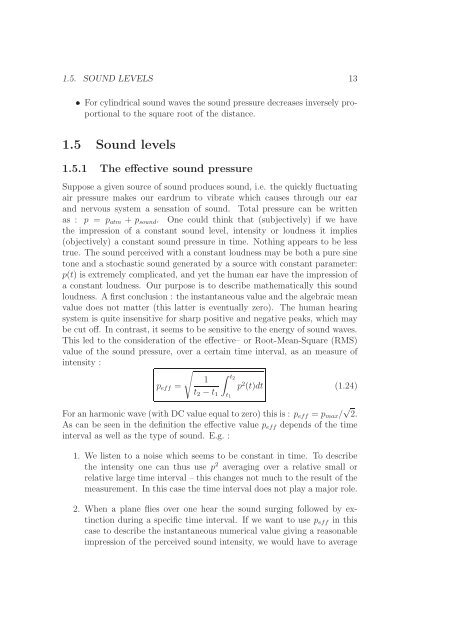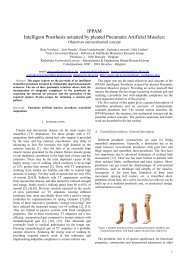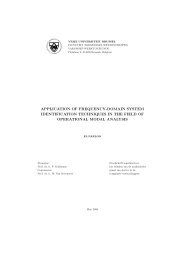VRIJE UNIVERSITEIT BRUSSEL Acoustics - the Dept. of ...
VRIJE UNIVERSITEIT BRUSSEL Acoustics - the Dept. of ...
VRIJE UNIVERSITEIT BRUSSEL Acoustics - the Dept. of ...
Create successful ePaper yourself
Turn your PDF publications into a flip-book with our unique Google optimized e-Paper software.
1.5. SOUND LEVELS 13For cylindrical sound waves <strong>the</strong> sound pressure decreases inversely proportionalto <strong>the</strong> square root <strong>of</strong> <strong>the</strong> distance.1.5 Sound levels1.5.1 The effective sound pressureSuppose a given source <strong>of</strong> sound produces sound, i.e. <strong>the</strong> quickly fluctuatingair pressure makes our eardrum to vibrate which causes through our earand nervous system a sensation <strong>of</strong> sound. Total pressure can be writtenas : p = p atm + p sound . One could think that (subjectively) if we have<strong>the</strong> impression <strong>of</strong> a constant sound level, intensity or loudness it implies(objectively) a constant sound pressure in time. Nothing appears to be lesstrue. The sound perceived with a constant loudness may be both a pure sinetone and a stochastic sound generated by a source with constant parameter:p(t) is extremely complicated, and yet <strong>the</strong> human ear have <strong>the</strong> impression <strong>of</strong>a constant loudness. Our purpose is to describe ma<strong>the</strong>matically this soundloudness. Afirst conclusion : <strong>the</strong>instantaneous valueand<strong>the</strong> algebraicmeanvalue does not matter (this latter is eventually zero). The human hearingsystem is quite insensitive for sharp positive and negative peaks, which maybe cut <strong>of</strong>f. In contrast, it seems to be sensitive to <strong>the</strong> energy <strong>of</strong> sound waves.This led to <strong>the</strong> consideration <strong>of</strong> <strong>the</strong> effective– or Root-Mean-Square (RMS)value <strong>of</strong> <strong>the</strong> sound pressure, over a certain time interval, as an measure <strong>of</strong>intensity :p eff =√1t 2 −t 1∫ t2t 1p 2 (t)dt (1.24)Foranharmonicwave(withDCvalueequal tozero) thisis: p eff = p max / √ 2.As can be seen in <strong>the</strong> definition <strong>the</strong> effective value p eff depends <strong>of</strong> <strong>the</strong> timeinterval as well as <strong>the</strong> type <strong>of</strong> sound. E.g. :1. We listen to a noise which seems to be constant in time. To describe<strong>the</strong> intensity one can thus use p 2 averaging over a relative small orrelative large time interval – this changes not much to <strong>the</strong> result <strong>of</strong> <strong>the</strong>measurement. In this case <strong>the</strong> time interval does not play a major role.2. When a plane flies over one hear <strong>the</strong> sound surging followed by extinctionduring a specific time interval. If we want to use p eff in thiscase to describe <strong>the</strong> instantaneous numerical value giving a reasonableimpression <strong>of</strong> <strong>the</strong> perceived sound intensity, we would have to average
















